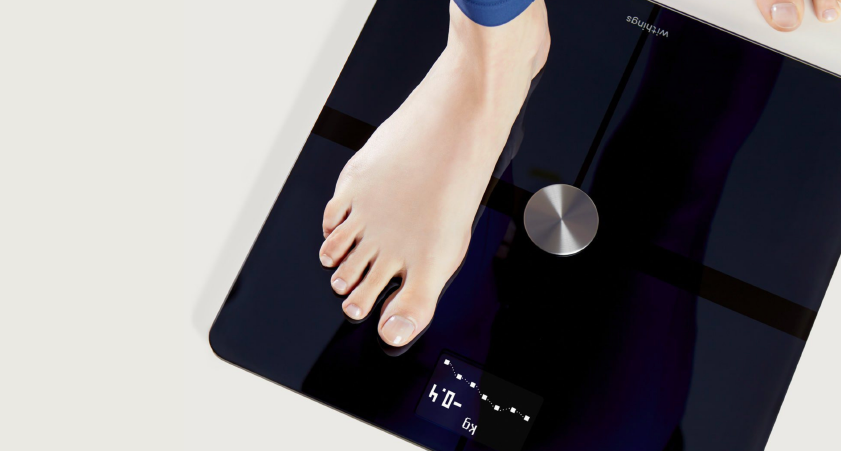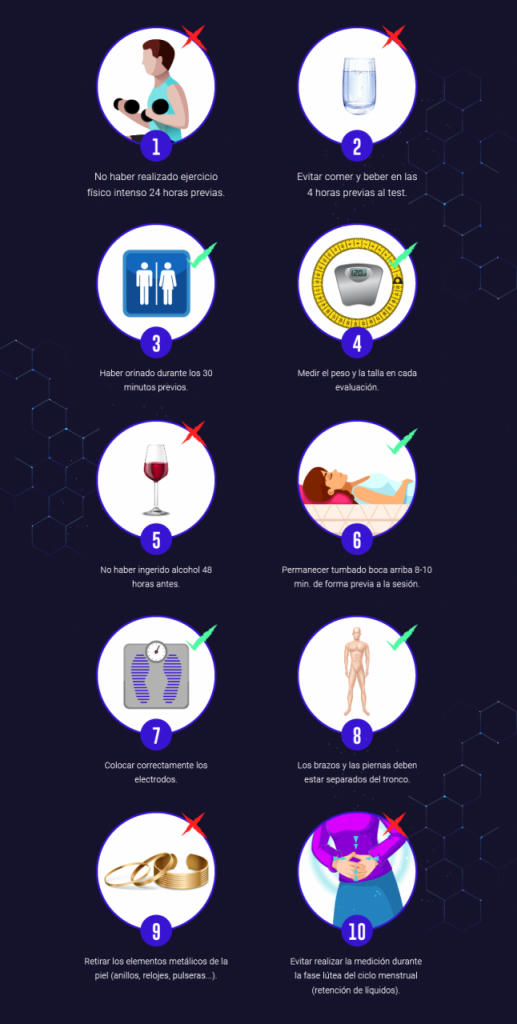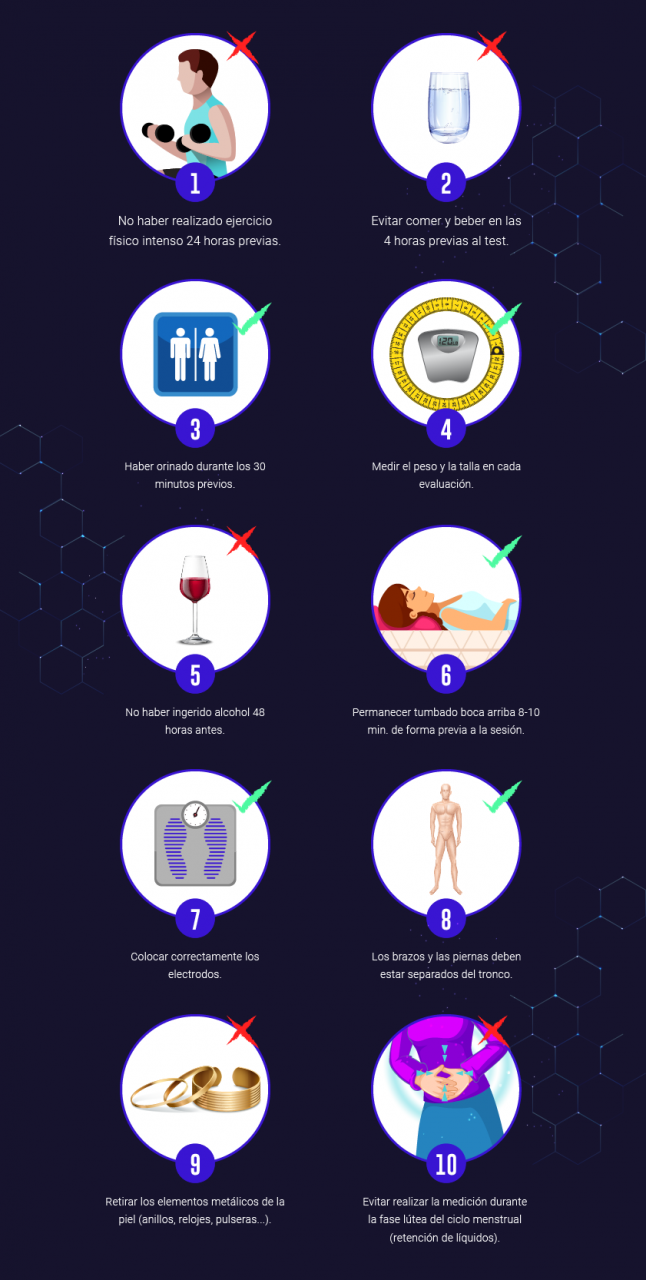In the post What is body composition and how to calculate lar percentage of fat We resolved several doubts about body composition, but now we want to explain well one of the most used methods to measure it: electrical bioimpedance (BIA).
BIA scales are a method to measure body composition (percentage of fat, kg muscle, visceral fat, etc.) in an easy, accessible and safe way. However, there are many doubts about the use and reliability of bioimpedance scales.
Can you trust the percentage of fat that your scale says you have? What types of scales are there? What are the best scales to know your% of fat and muscle?
In this post you will not only find the answer to these questions, but you will also find useful tips to optimize measurements and a selection of 10 BIA scales to personal use.
What is electrical bioimpedance and how does it work?
BIA is a doubly indirect method of assessing body composition. It is an accessible, easy to use and safe method.
Bioimpedance machines send an electrical impulse and measure its resistance (or impedance) through the body. Its operation is based on the fact that the electrical conductivity of water varies depending on the tissue (muscle, fat, bone …). For example, fat mass has low electrical conductivity because it has very little water, while fat-free mass (muscles, bone, blood vessels …) have a high percentage of water and, therefore, good electrical conductivity. This allows saying that the more fat, the more resistance (or impedance) .
But the BIA does not measure fat or muscle, measures the impedance that each part of the body generates to an electrical current applied at a certain frequency. Once it has that value in hertz, it applies a formula that takes into account factors such as weight or age, but not all scales use the same formulas.
Most scales on the market use their own formulas (made by the manufacturer) that are generally not validated for all population groups. For example, if a scale uses a formula validated with athletic Japanese men ages 21-27, it will not provide valid values for a 75-year-old sedentary Caucasian lady.
At the IND center – Valencia , we measure and value using bioimpedance or anthropometry in depending on the needs of each person. If you want to know more details about anthropometries (another method to know body composition), you can click on the post A ntropo metrics: what it is, what it measures and what it is for
What types of bioimpedance exist ?
We found a fairly wide range of BIA scales and the main characteristics that we can find among them are the following:
- Monofrequency vs multifrequency . Although both allow the quantification of body water, the multifrequencies are more precise and also allow differentiation between intracellular and extracellular water.
- Total vs segmental . Segmentals have the added ability to offer results by body area (percentage of fat in the right, left arm… .etc). For example, a segmental BIA scale can be useful to know the accumulation of fluids in the abdominal area.
- Basic vs Complete. The basic ones assess the electrical impulse in an area of the body and usually contain two contacts (usually one on each hand or one on each sole of the foot). Meanwhile, the complete ones collect the data in both the upper and lower trunk and usually have contacts in the feet and hands. The greater the number of contacts and sensors (or electrodes), the less margin of error.
There are also many other differences, such as connectivity (eg, some connect via bluetooth to Apps like My Tanita App or Google Fit) or the maximum weight range allowed (eg Those for personal use usually perform the calculations up to a maximum of 150 or 180kg).

Selection of 10 bioimpedance scales:
L What is clear is that the number of BIA scale brands and models is constantly increasing. Therefore, below we leave you a selection of 10 bioimpedance scales for personal use that are valid for different population groups:
- OMRON BF511: 4 contacts (hands and feet) • 8 sensors • non-segmental • no bluetooth connection
- Withings Body + : 2 contacts (feet) • 4 sensors • non-segmental • with wifi connection
- TANI T A BC 587: 2 contacts (feet) • 4 sensors • non-segmental • no bluetooth connection
- BEURER BF 105 : 4 contacts (hands and feet) • 8 sensors • segmental • with bluetooth connection
- TANITA BC-545N : 4 contacts (hands and feet) • 8 sensors • segmental • without bluetooth connection
- OMRON 508: 4 contacts (feet and hands) • 8 sensors • non-segmental • without bluetooth connection
- TANITA BC-601: 4 contacts (hands and feet) • 8 sensors • segmental • without bluetooth connection
- OMRON VIVA: 2 contacts (feet) • 4 sensors • non-segmental • with bluetooth connection
- TANITA BC 401: 2 contacts (feet) • 4 sensors • non-segmental • with bluetooth connection
- TANITA RD-545 : 4 contacts (feet and hands) • 8 sensors • segmental • with connection Bluetooth
Are the bioimpedance results reliable ?
The million dollar question. The BIA results can be valid when scientifically validated formulas are used for a specific group of people of a certain ethnicity, age, sex, height … and as long as the conditions in which the measurement is carried out are very well controlled. That is not easy.
As we have seen, many of the scales that we can buy today use formulas that are not scientifically validated for all population groups, but this does not mean that they do not work. In fact, using a BIA scale can be of great help to measure your progress, especially if you follow a planning with a online nutritionist .
They are reliable when:
- We focus on the trend and not on today’s specific data
- We are methodical when it comes to maintaining the conditions to measure ourselves
- We compare ourselves only with ourselves and with the same scale to see how we are evolving
They are not as reliable when:
- We are part of a research team that wants to know the relationship between the body composition of cyclists and the phase of the season in which they encounter a sample of people of different ages, sexes and ethnicities.
- It is performed in people with fluid retention, peripheral edema, hydrostatic problems or who use diuretic medication
- We are looking for a very tight performance improvement, as the error is 3%. A mistake too high to spin all the fine we like.
- There are slight changes in the place where we place the electrodes. These changes can produce a variability of 2% on different days and, if we do not control all the conditions, the error will increase even more.
Guidelines to optimize the results in a bioimpedance
L he results of the bioimpedance will be highly variable and unreliable if we do not maintain a series of conditions to measure ourselves.
Assuming that the BIA is far from perfect, with these guidelines you will achieve the highest possible accuracy:

It will also be important to point out situations such as abdominal obesity, large muscle mass, weight loss, menstrual cycle and menopause.
Levels of validity of the measurement
Same scale and same person
This case would be the only one we recommend, as long as you follow the rules that we have indicated above
Same scale and different people
At this point, you probably sense that it doesn’t make much sense to compare yourself to someone else even using the same BIA. This is because we must take into account that there are other factors that would influence the results, in addition to the amount of fat we have, how hydrated we are, the physical activity that we have done the previous hours, what we have eaten, the position of the body, the placement of the electrodes or the temperature of the skin and air, among others. The human body is not uniform, neither in length, nor in its cross-sectional areas, nor in ionic composition, and these anatomical differences are also a factor to take into account. For example, two people of the same height may have different leg lengths, which would influence the results of the BIA
Same person and different scales
In the event that the scales are different, you could not compare yourself or yourself, because they would probably use different formulas and the data they would give you would be completely different.
Different people and different scales
It makes no sense to compare different people who have measured themselves with a scale each time.
Conclusions
Considering everything we have seen throughout the post, the BIA is not a panacea, but it is a technology that can be very useful. In the case of using it:
- Do not keep the data isolated. The important thing is the evolution of the trend.
- The important thing is not so much the weight, but how you have that weight distributed.
- To minimize the margin of error, follow the guidelines indicated in the post.
- A good interpretation of the results is crucial. A bad diagnosis leads to following the wrong guidelines that could be counterproductive to your performance or health. In this task, a sports nutritionist is of great help to understand the reason for the changes.
- Always the same scale and compare yourself only to yourself.
If you are interested in learning more about increasing muscle mass, losing fat, why you gain weight or lose weight … etc, our Body Composition workshop comes to the gram.

